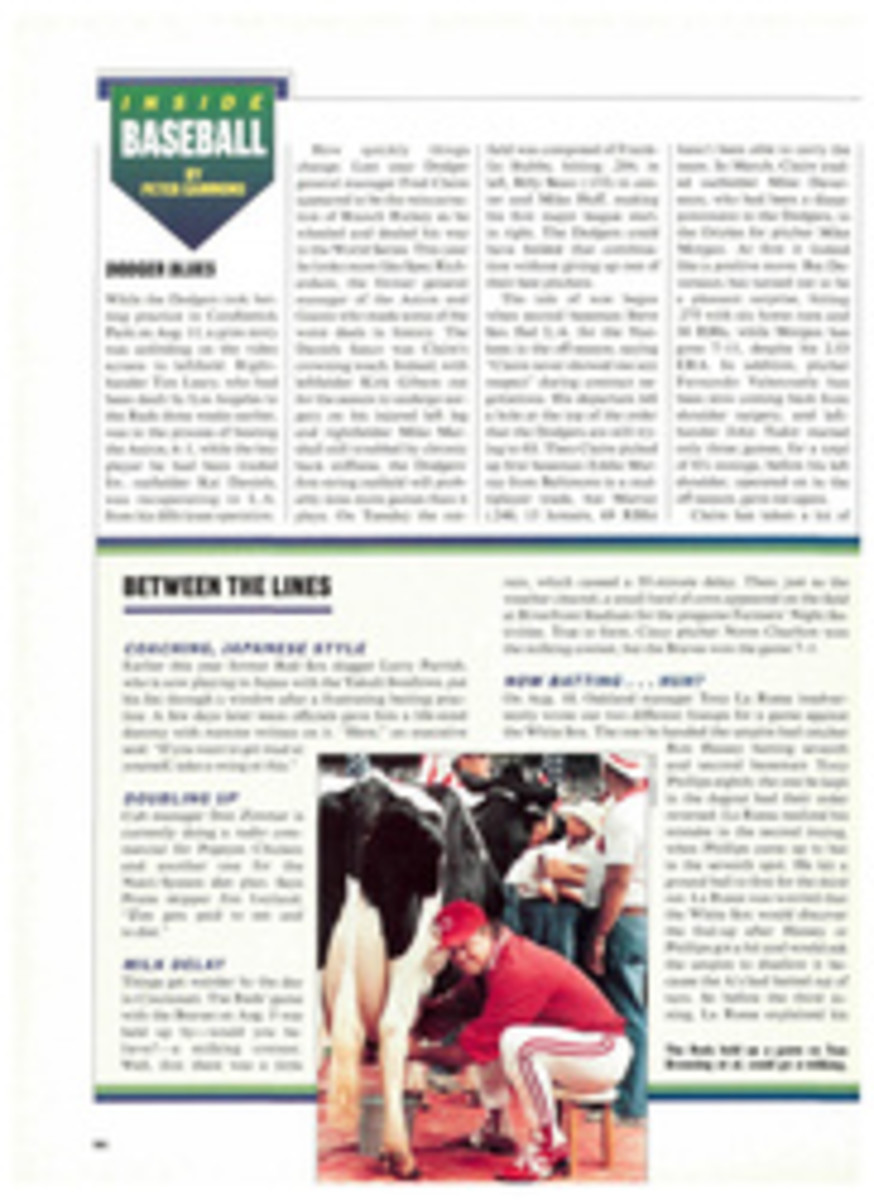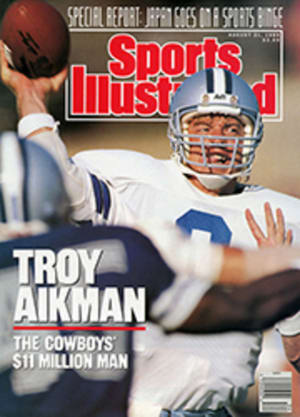
AIM FOR THE STARS
Kazuhiro Mizoguchi's muscles battled the sleeves of his T-shirt as he scribbled autographs for young fans at the national track and field championships in Tokyo last June. A month earlier, at the Bruce Jenner meet in San Jose, he threw the javelin 287'5", two inches shy of the world record. That toss made him Japan's newest sports hero—and in a sport in which few thought a Japanese could excel. The 5'9", 218-pound Mizoguchi is one of his country's biggest athletes, dwarfed only by the sumo wrestlers. But his size and his international success are the exception, rather than the rule, in Japan.
In a country with a population of 123 million and a per capita income of some $16,000—about the same as in the U.S.—where millions of people play golf (or at least hit golf balls) and millions more play tennis, watch baseball games, jog and swim, it seems odd that there are so few athletes who can compete with the world's best. "With our work ethic, determination and money to train, you would think that we'd dominate every area where size wasn't the overriding factor in winning and losing," says Katsuya Hayashi, director of the Japan Amateur Sports Association (JASA).
And yet, how many Japanese sports stars can the average American name? Yes, there's Midori Ito, the tiny buzz bomb who won the women's world figure skating title in Paris last March. And Japan has produced a number of fine pro golfers: Isao Aoki, Jumbo Ozaki, Tommy Nakajima and Ayako Okamoto have been among the top players on the pro circuits. But who else? At the Seoul Olympics, Japan won only four gold medals, in swimming, judo and freestyle wrestling, while South Korea won 12; Hungary (pop. 10.5 million), 11; and East Germany (pop. 16.7 million), 37.
The reasons for this lack of world-class athletes? Sports officials in Japan point to the country's grueling educational system, poor organization at the grass roots of sports and the do-your-best mentality of the Japanese, which honors athletes who turn in gritty performances as much as athletes who win. There are also physical differences, they say, the ones which Mizoguchi has seemingly overcome.
"We do not have the same natural abilities as foreign athletes," says Mizoguchi, repeating a prejudice that even many Japanese believe. "And our thinking is not creative enough to overcome them. We should be training harder, training differently, eating different foods. But we don't think that way so much."
Mizoguchi, 27, had never even heard of the javelin until he watched a track meet on television when he was in high school in Shirahama. His school didn't have a javelin, so he started practicing with long sticks. "I could throw a baseball pretty far, so I knew I had a good arm," he said. "But nobody encouraged me to lift weights or told me I should try harder until I started doing it myself."
Few Americans can understand the self-discipline it took for a Japanese student to learn a sport on his own. First, individual initiative is not encouraged by the Japanese culture. And the education system is so competitive—the schools you attend virtually determines your career—that children are forced to spend after-school hours in cram schools rather than on ball fields or in gyms. More than 45% of all junior high school students are enrolled in these schools, which give mock entrance tests on Saturdays.
"Parents would much rather have their sons and daughters get into Tokyo University than become professional athletes." says Setsuo Watanabe, a writer with Mainichi Shimbun, one of the major Tokyo newspapers. "And our 'exam hell' doesn't give them a chance to spend time to learn sports properly if they wanted to."
Children who do find time for sports are instructed by teachers who are not paid to coach but are expected to do so by their schools. This is a practice vehemently opposed by the teachers' union, which encourages its members not to do anything without pay. As a result, the sports system is disorganized and coaching is often sporadic. Upper level and national teams are usually coached by former team members, who may have been fine athletes but aren't necessarily good instructors. And the training facilities in Japan, because of the lack of land, are few and crowded. It is not unusual to see 30 children squeezed onto one tennis court for instruction. "How do they learn anything but how to stand in line?" one observer asks.
Private athletic lessons are expensive in Japan. When seven-year-old Soichiro Hayashi decided to switch from swimming to karate lessons, his father, Takeyuki, sighed with relief. Swimming instruction twice a week costs $400 a month; twice-weekly karate lessons are $24 a month. "He might have become an Olympic swimmer, but it would have taken a lot more money and time," says Takeyuki Hayashi (no relation to Katsuya Hayashi).
The Japanese haven't always been so-so athletes. At the L.A. Games in 1932, Japanese athletes won seven gold medals, fifth among the competing countries; they took home six golds from the Berlin Olympics of 1936, seventh among all countries. After World War II, however, there was little time or energy for sports in the ruined country, but as Japan was rebuilt, so was the desire to compete.
"Food was scarce, it was a very difficult era for the Japanese people," says Seiichi Tanaka, director of physical education at Tokai University. "But we had a high level of pride and fighting spirit then. We were hungry to win." That was evident in the 1964 Olympics, held in Tokyo. The men's gymnastics team won five of eight gold medals and the judo team three of four golds; the Japanese won 16 golds altogether.
"You don't see that hunger today," Tanaka says. "Life is very good in Japan now. We used to eat rice for physical strength; now we eat rice for mental strength."
The decline in sports began after the 1964 Olympics when, as Tanaka says, life became easier. The Japanese students" antigovernment movement in the late 1960s did nothing to stem the slide. "The charm of sports died in our young people," says Katsuya Hayashi. "Students saw athletes as privileged people, treated like stars by the government. They began a movement to restrict sports activity by students. It was a very severe power struggle."
The effects of the struggle remain today. Only 5% of the athletes on Japan's Seoul Olympic team were students, compared to 40% of most European teams. JASA hopes to change that, and recently some progress has been made. Parents now see a child, who because he attended a low-prestige university would never have been employed by a major firm like Hitachi, hooking up with Hitachi because he is good in volleyball and can help the company team. "They see money being paid to athletes other than just professional baseball players," Tanaka says. "And that helps them rationalize spending money and time on sports lessons."
Furthermore, because of the Japanese team's poor showing at Seoul, the Ministry of Education increased the budget for JASA by $2.8 million, to $8.6 million, and initiated a stipend system to pay for training and housing of the country's top athletes. Mizoguchi, for example, had his stipend doubled to $2,400 a month after his performance in San Jose. "The government is now concerned," JASA's Hayashi says. "It sees the importance of a strong sports system."
Tokai and Keio universities have begun research on nutrition and dietary supplements to help Japanese athletes make gains in weight and size. "There are natural things available that can elevate cardiovascular ability and increase size," says Hayashi. "It's important right now to think about nutrition and getting our athletes to eat better. Some students still eat noodles five times a week."
And many have not discovered weight training. "We are considered weak people and that is a shame," says Hirokazu Kobayashi, who coaches decathletes on the national team. "But it is for lack of training. We need to increase training for strength."
With stars such as Mizoguchi, who can bench-press 418 pounds and squat 490 pounds, as role models, Japanese sports officials hope that young athletes will become interested in events that require size and strength. "Mizoguchi is the new breed of athlete," says Hayashi. "If we can keep the good aspects of Japanese tradition and adapt to this age of technique, we can one day be dominant."
PHOTO
ANDY HAYT
MIZOGUCHI THREW THE JAVELIN A NEAR-RECORD DISTANCE IN SAN JOSE TO BECOME AN INSTANT HERO
PHOTO
HEINZ KLUETMEIER
A PAIR OF ACES: ITO WOWED 'EM AT THE '89 WORLDS AND OKAMOTO HAS WON BIG ON THE TOUR
PHOTO
DAVID CANNON/ALLSPORT
[See caption above.]

